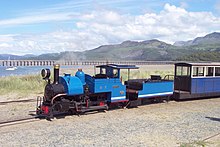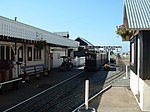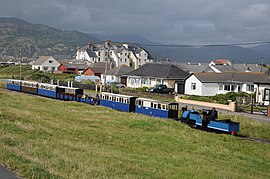Fairbourne Railway
| Fairbourne Miniature Railway | |||||||||||||||||||||||||||||||||||||||||||||||||||||||||||||||||
|---|---|---|---|---|---|---|---|---|---|---|---|---|---|---|---|---|---|---|---|---|---|---|---|---|---|---|---|---|---|---|---|---|---|---|---|---|---|---|---|---|---|---|---|---|---|---|---|---|---|---|---|---|---|---|---|---|---|---|---|---|---|---|---|---|---|
| Route length: | 3.2 km | ||||||||||||||||||||||||||||||||||||||||||||||||||||||||||||||||
| Gauge : |
(1895-1916) 610 mm (1916-1984) 381 mm (1984-present) 311 mm |
||||||||||||||||||||||||||||||||||||||||||||||||||||||||||||||||
| Owner: | North Wales Coast Light Railway | ||||||||||||||||||||||||||||||||||||||||||||||||||||||||||||||||
| operator | Fairbourne Railway Limited, supported by the Fairbourne Railway Preservation Society |
||||||||||||||||||||||||||||||||||||||||||||||||||||||||||||||||
|
|||||||||||||||||||||||||||||||||||||||||||||||||||||||||||||||||
The Fairbourne Railway ( Welsh : Rheilffordd y Friog ) is a miniature narrow- gauge railway with a gauge of 311 mm today and a length of 3.2 km. It leads from the coastal town of Fairbourne in north central Wales along the beach on a peninsula to the pier of the Barmouth Ferry, a ferry with which passengers can cross over the mouth of the River Mawddach to the seaside resort of Barmouth . The railway has always been a tourist railway and, unlike many other narrow-gauge railways in Wales, was only important for freight traffic in its early days.
history
The railway opened for the transport of building materials in 1895 as a horse-drawn railway with a gauge of 2 feet (610 mm). It offered a service between Fairbourne Village and Penrhyn Point and was re-gauged to 381 mm in 1916 and to its current gauge of 311 mm in 1986. It has been used by tourists since its early days. It reached the highest passenger numbers with 70,000 passengers in 1970.
The horse-drawn tram from the beginning
As the area around Fairbourne became accessible to day trippers from the Midlands after the completion of the Cambrian Coast Line in 1865 and the Barmouth Bridge in 1867 , there were various plans to develop tourism in this area. At this point in time there were already several horse-drawn trams, mainly for the removal of stones from the Henddol quarry above the neighboring town of Friog . The horse-drawn tram that was built for the construction of the town of Fairbourne soon introduced passenger cars to transport people to the ferry terminal and the beach.
The early days of the Fairbourne Miniature Railway
In 1916 the line was re-gauged to 381 mm (15 inches) , a gauge widely used in miniature and park railways , and operated by Narrow Gauge Railways Ltd (NGR) with a Wenman Joseph Bassett-Lowke steam locomotive . The aim of the company was to promote tourism in this area. The locomotives used were the Prince Edward of Wales Bassett Lowke Class 10 locomotive , developed by Henry Greenly . The passengers were carried in four open cars. The railroad also played an important role in the development of the 15 inch gauge railways in the United Kingdom.
During the Second World War, the railway had changing owners, among other things, it was temporarily rented by the operator of the ferry. After the acquisition of a 457 mm (18 inch) gauge locomotive, a GNR Stirling 4-2-2, a third track was laid to the golf course . In 1940 a Lister Railtruck diesel locomotive was used, after which the railway was closed.
The Wilkins Era: 1947–1984
A consortium of business people from the Midlands saved the railway in 1946 and after restoration work it was reopened in 1947. The owner of the railway, John Wilkins, invested in the renewal of the railway facilities and bought new steam locomotives. The railway had its best days in the 1960s and 1970s. With the advent of cheap air travel and mass tourism in southern countries and the revival of several disused narrow-gauge railways in the region as museum railways , the number of passengers continued to decline in the 1970s and 1980s.
The Ellerton Era 1984–1995
In 1984 the train was sold to the Ellerton family. The track was re-gauged to 311 mm (12 inches) in 1986, and a new terminus was built in Fairbourne. Four new steam locomotives for the new gauge were purchased and the old locomotives for the 15-inch gauge were sold. Two of the new locomotives came from the insolvent Réseau Guerlédan Chemin de Fer Touristique in Brittany in France. All four steam locomotives Yeo , Sherpa , Beddgelert and Russell are scaled-down replicas of real narrow-gauge railroad locomotives. Of the 15-inch locomotives, only the Sylvia diesel locomotive (rebuilt as Lilian Walter ) remained on the line. Most of the 15-inch locomotives, however, are still intact and have found a new application on other railways.
In 1990 the first own steam locomotive, the number 24, was built. It is a scaled-down replica of a tender locomotive on the Sandy River & Rangeley Lakes Railroad in Maine . This locomotive now runs on the Cleethorpes Coast Light Railway in Lincolnshire .
The Fairbourne Railway was offered for sale again in 1990 and its future prospects appeared rather bleak. It was for sale for five years and its technical condition deteriorated noticeably.
Since 1995

In April 1995 the track was acquired by Professor and Mrs. Atkinson and Dr & Mrs. Melton. They invested significant resources in the condition and reliability of the locomotives, the route and an additional attraction: the Rowen Nature Center at Fairbourne Station. Since 2007, a model railway in size IIm has been built and constantly expanded.
In order to secure the future of the Fairbourne Railway, ownership of it was transferred in February 2009 to the non-profit organization The Fairbourne Railway Preservation Society , which has been running the railway since then, mainly with volunteers. Whether the existence of the railway can be secured in the long term seems at least doubtful, as the town of Fairborne should be abandoned by 2045 at the latest due to the rising sea water level and then the railway will probably no longer be salvable.
The ferry
A ferry connection to bridge the mouth of the Mawddach has existed for hundreds of years. It was originally run by monks. It was operated by private individuals from around the beginning of the 20th century and was finally taken over by the railway company in 2007. By purchasing the new Y Chuff ferry boat and taking over the ferry operations, this could also be ensured in the off-season.
Stations
| image | designation | description |
|---|---|---|

|
Fairbourne | Fairbourne station is the headquarters of the line with halls for the locomotives and wagons. A museum shows photos of the railway line and a model railway. There is also a nature information center, a tea room, a souvenir shop and a ticket office. The railway line runs from here over Beach Road and three road crossings to Beach Halt. |

|
Beach stop | Beach Halt serves the beach, a parking lot and an amusement hall. The station was formerly called Bathing Beach . Trains arrive around 4 minutes after departing from Fairbourne. From here the route goes north along the beach through the dunes to the golf stop. |

|
Golf stop | Golf Halt serves a 9-hole golf course and the beach. Trains arrive around 7 minutes after departure from Fairbourne. From here it goes north on the dike to the station Loop Halt. In the meantime the station had the name Gorsafawddacha'idraigodanheddogleddollônpenrhynareurdraethceredigion , which made it the station with the longest name in the world. However, in 2007 it was renamed back to its original name. |

|
Loop stop | Loop Halt serves the footpath on the dike to Morfa Mawddach station of the Cambrian Line and its Barmouth Bridge. Trains arrive approximately 9 minutes after departing from Fairbourne. The stop has a second track so that the opposite train can pass here. After the stop, the route reaches the sand dunes. |

|
Estuary stop | The Estuary Halt is near the Jack Steele Tunnel and is the parking lot at the end of Penrhyn Drive North. Trains arrive at the stop approximately 16 minutes after departure from Fairbourne. From here the route runs through the tunnel to Barmouth Ferry. |

|
Barmouth Ferry | Barmouth Ferry is the northern terminus and has a turning loop . The "Harbor View café" is located in the station building. Passengers can take the passenger ferry to Barmouth. |
bibliography
Books:
- JIC Boyd: Narrow Gauge Railways in Mid Wales. 1965.
- S. Buck: Siân and Katie - The Twining Sisters. Siân Project Group, 1995.
- S. Buck: EW Twining, Modelmaker, Artist & Engineer. Landmark Publishing, 2004, ISBN 1-84306-143-0 .
- Alan C. Butcher (Ed.): Railways Restored 2005 . Ian Allan Publishing, Hersham, Surrey 2005, ISBN 0-7110-3053-7 .
- WJ Milner: Rails through the Sand . Rail Romances, Chester 1996, ISBN 1-900622-00-9 .
- J. Wilkins: Fairbourne Railway - A Short History of It's Development and Progress. 1961.
- Fairbourne Railway: Souvenir Guide Book. 2005.
Magazines
- One Foot Between The Rails (issued quarterly by the Fairbourne Railway Preservation Society )
multimedia
- Tracks in the Sand The Story of the Fairbourne Railway - A film by Eric Montague Website
Web links
Individual evidence
- ^ WJ Milner: Rails Through The Sand . Rail Romances, 1996.
- ^ Mawddach Cresent History page. Archived from the original on March 21, 2002 ; Retrieved December 28, 2010 .
- ^ G Scale Model Railway. Retrieved December 28, 2010 .
- ^ Preservation Society. Retrieved December 28, 2010 .
- ↑ Why Britain is now giving up entire villages. Retrieved July 29, 2019 .
- ↑ Ferry Service. Retrieved December 28, 2010 .




